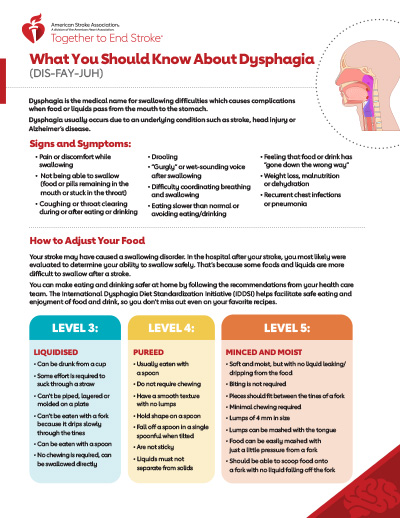What You Should Know About Dysphagia
 Dysphagia (dis-fay-juh) is the medical name for swallowing difficulties which causes complications when food or liquids pass from the mouth to the stomach.
Dysphagia (dis-fay-juh) is the medical name for swallowing difficulties which causes complications when food or liquids pass from the mouth to the stomach.
Dysphagia usually occurs due to an underlying condition such as stroke, head injury or Alzheimer’s disease.
Signs and Symptoms:
- Pain or discomfort while swallowing
- Not being able to swallow (food or pills remaining in the mouth or stuck in the throat)
- Coughing or throat clearing during or after eating or drinking
- Drooling
- “Gurgly” or wet-sounding voice after swallowing
- Difficulty coordinating breathing and swallowing
- Eating slower than normal or avoiding eating/drinking
- Feeling that food or drink has “gone down the wrong way”
- Weight loss, malnutrition or dehydration
- Recurrent chest infections or pneumonia
How to Adjust Your Food
Your stroke may have caused a swallowing disorder. In the hospital after your stroke, you most likely were evaluated to determine your ability to swallow safely. That’s because some foods and liquids are more difficult to swallow after a stroke.
You can make eating and drinking safer at home by following the recommendations from your health care team. The International Dysphagia Diet Standardization Initiative (IDDSI) helps facilitate safe eating and enjoyment of food and drink, so you don’t miss out even on your favorite recipes.
Level 3:
Liquidised
- Can be drunk from a cup
- Some effort is required to suck through a straw
- Can’t be piped, layered or molded on a plate
- Can’t be eaten with a fork because it drips slowly through the tines
- Can be eaten with a spoon
- No chewing is required, can be swallowed directly
Level 4:
Pureed
- Usually eaten with a spoon
- Do not require chewing
- Have a smooth texture with no lumps
- Hold shape on a spoon
- Fall off a spoon in a single spoonful when tilted
- Are not sticky
- Liquids must not separate from solids
Level 5:
Minced and moist
- Soft and moist, but with no liquid leaking/ dripping from the food
- Biting is not required
- Pieces should fit between the tines of a fork
- Minimal chewing required
- Lumps of 4 mm in size
- Lumps can be mashed with the tongue
- Food can be easily mashed with just a little pressure from a fork
- Should be able to scoop food onto a fork with no liquid falling off the fork
Level 6:
Soft and bite-size
- Soft, tender, and moist but with no thin liquid leaking/dripping from the food
- Ability to bite off a piece of food is not required
- Ability to chew bite-sized pieces so that they are safe to swallow is required
- Bite-size pieces are no bigger than 1.5 cm x 1.5 cm in size, about the size of a thumbnail
- Food can be mashed/broken down with pressure from a fork
- A knife is not required to cut food
Level 7:
Regular
- Normal, everyday foods of various textures that are developmentally and age appropriate
- Ability to bite off pieces of food is required
- Chewing ability is required for hard and soft food
- Ability to chew all types of food textures without tiring easily
- May include mixed consistency foods, for example, cereal with milk or soup with vegetable pieces
- Includes sandwiches
Please consult with your health care professional, such as speech-language pathologist, to best determine your needs.
Examples of Safe Swallowing Techniques:
Work with your speech-language pathologist to develop your personal tips for safer swallowing.
- Sit upright at 90° during meals for at least 30 minutes afterward.
- Ensure head and neck are aligned, not tilting back or to the side.
- Take small bites and sips.
- Chew thoroughly and swallow completely before taking the next bite.
- Avoid talking while eating.
- Eat slowly and take breaks between bits.
- Follow the recommended texture levels from your health care team.
- Minimize distractions such as TV, phone or conversation during meals.
- Swallow twice after each bite or sip.
- Watch for signs of aspiration: coughing, throat clearing, shortness of breath after eating.
- Maintain good oral hygiene to reduce risk of bacteria that can lead to pneumonia.
Foods to Avoid
- Hard, crunchy or dry foods: nuts, seeds, crackers, chips, pretzels, crusty bread, raw vegetables, popcorn
- Mixed texture foods: soups with chunks (e.g., chicken noodle soup), cereal with milk, canned fruit in syrup, salads with dressing
- Sticky or chewy foods: peanut butter, marshmallows, dried fruits (e.g., raisins)
- Thin liquids (if not cleared by your health care professional): water, juice, broth-based soups, ice cream
- Foods that crumble or flake: rice, cornbread, flaky pastries, granola
- Stringy/fibrous foods: celery, pineapple, melted cheese
- Vegetable and fruit skins: beans, peas, potatoes, orange segments, grapes
Nationally supported by Encompass Health.
© Copyright 2025 American Heart Association, Inc., a 501(c)(3) not-for-profit. All rights reserved. American Stroke Association and Together to End Stroke are registered trademarks of the AHA. Unauthorized use prohibited. WF973000 9/25
© The International Dysphagia Diet Standardisation Initiative 2019 @ https://iddsi.org/. Licensed under the CreativeCommons Attribution Sharealike 4.0 License https://creativecommons. org/licenses/by-sa/4.0/legalcode.